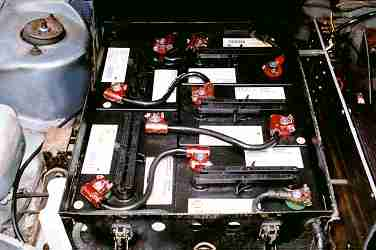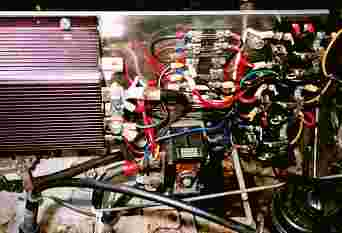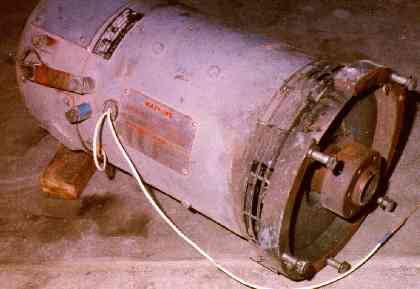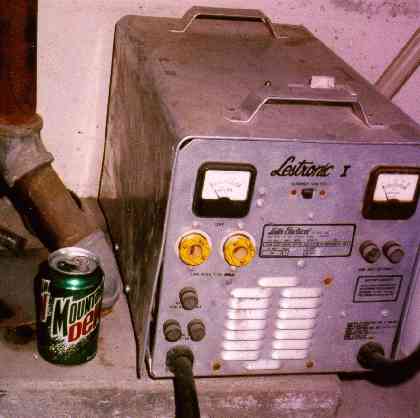Just click on any image for a closer look.

Specifications
|
| Base Car: |
1980 Plymouth Horizon Coupe |
| Converted: |
Factory conversion in 1980
by Jet Industries |
| Miles Electric: |
21,000 |
| Range: |
40 to 60 miles. |
| Top Speed: |
70 miles per hour. |
| Recharge Time: |
3 to 6 hours on 220 VAC |
| Capacity: |
4 adults. |
| Curb Weight: |
3460 Pounds. |
| Voltage: |
120 Volts |
| Motor: |
23 hp General Electric Series
Wound DC Traction Motor |
| Batteries: |
20 NAPA 8145 Deep Cycle Lead
Acid Batteries |
| Controller: |
Curtis 1221B MOSFET Controller |
| Charger: |
Off Board Lester 220 VAC, Portable
Home-Made "Bad Boy" Charger 120 VAC. |
| DC/DC Converter: |
Todd LV-40 |
| Heater: |
120 VDC Ceramic, 120 VAC Pre
heater |
Under the Hood
|

Lets take a quick peak under the hood. The large
black box contains five of the car's twenty batteries. Below it, just out
of sight is the drive motor. It is connected to a flywheel and clutch just
as would be used in a conventional car. On the right you can just make
out the plate that the controller and relays are mounted on. |
The Controller and Relays
|

The large blue black component on the left is
the Curtis Controller. It acts rather like a large dimmer to control the
power fed to the motor. Near the bottom about center you can see the Main
Contactor. This is the master switch between the batteries and the controller.
Above the contactor are the heater and voltmeter fuses. To the right are
the relays. The top one is for pre charging the controller, the middle
one is for the heater element, and the bottom one controls the main contactor
through the ignition switch. In the bottom right of the screen you can
see the top of the master cylinder for the brakes. |
The Rear Battery Box
|

There is not too much to see here. Again we have
a large box, this one with fifteen batteries in it. A blower to vent the
batteries during charging is mounted under the carpeted panel to the left
of the box. The Todd LV-40 DC/DC Converter is mounted under the panel on
the right. |
The Drive Motor
|
 |
| This is a 23 horse power General Electric drive motor. This isn't
mine, but this one is out of an identical Jet 007. The GEs don't
have an internal cooling fan so they require an external blower.
If 23 horse power doesn't seem like much, you have to remember that electric
motors and gas engines measure power ratings differently. Gas engines
are rated at their peak horse power, even though they can only maintain
it for a few minutes without overheating or breaking. Electric motors
are rated at their continuous horse power, which they can maintain indefinitely.
The peak horse power of this GE motors is around 64 horse power, limited
by the controller. With a larger controller or higher battery voltage
it can produce much much more power. It only takes about 15 horsepower
to drive a car at speed on the highway. |
The Battery Charger
|
 |
| This is the old Lester "Buzz Box", a rather noisy ferro-ressonant charger.
It is far to large and heavy to carry on the car, and since it require
220 AC power, it wouldn't be much use anyway. I will be adding a
small on-board charger sometime in the future. |
|
The "Bad Boy" Charger
|
 |
| This is my version of the notorious "Bad Boy" charger. It is
an unregulated, non-isolated, UL disapproved charger. I built
mine into an old NAPA 6 amp 12 volt battery charger, so it has dual
outputs. My car requires 12 volt power for the battery vent fan.
I used several heavy resistors in mine to allow me to have some control
over the charge rate. I had to add a cooling fan to keep the heat
under control. With low batteries it puts out about 8 amps on low,
12 amps on medium, and on high it trips its 20 amp breaker. Voltage
wise, on medium if left overnight it tapers down to about 3 amps at around
150 volts. It makes a very handy portable charger, but I wouldn't
want to use it all the time. I will be adding a GFI to it shortly. |
How it all works together
|

|
This is how it all works together.
-
Household power is fed into the Battery Charger from the wall outlet.
-
The Battery Charger converts the incoming 220 volt alternating current
into 120 volt direct current which is fed into the Battery Pack.
When the Battery Pack reaches full charge the charger shuts off.
-
The Battery Pack chemically stores the electricity for later use.
Power is fed from the Battery Pack to both the Main Contactor and the DC/DC
Converter.
-
The Main Contactor is the master on-off switch for the car. Direct
current is fed from the Battery Pack through the Main Contactor to the
Controller.
-
The Controller regulates the power flow from the Battery Pack to the Motor,
in much the same way as a dimmer controls a light.
-
The Motor converts the electric power supplied by the Controller into mechanical
force. This is in turn fed through the original clutch and transmission
to the drive shafts and out to drive the front wheels.
-
Electric power is also supplied from the Battery Pack to the DC/DC Converter.
This acts rather like an alternator, by changing the 120 volt direct current
from the Battery Pack into 12 volt direct current to charge the Auxiliary
Battery. The Auxiliary Battery supplies the 12 volt power for headlights,
fans, and the radio.
|
For the moment, this concludes our tour.
If you have any questions about my car please
e-mail me. Send e-mail to:
Mike Chancey at:

This page hosted by 
Get your own Free Home Page
|







